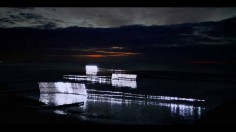HUMAN TIDE
syzygy and unique, in partnership with park village
(Inspired by Duchamp’s genre defining piece, 3 Standard Stoppages)
source: syzygy
Human Tide is a celebration of the centenary of legendary artist Marcel Duchamp’s time in the UK and is inspired by his work Three Standard Stoppages.The event took place in Herne Bay on the Kent Coast. At sunset, we walked along a kilometre of beach three times, using the tide to guide our direction. Each of us carried a big light stick made especially for the occasion, to create a “wall of light.” All three walks were filmed from the pier with a special 3D camera set up, allowing us to capture the walker’s light trails on film. See the result in the video above!This was a major collaborative project with many partners. Syzygy and our sister agency unique digital brought everything together as Exec Producers on the project with Rob Lawrence’s creative vision and direction; Park Village and Here There Everywhere produced the film; Native made the sonar-guided light-sticks; ENVY looked after post-production and Paul Hartnoll from Orbital made the soundtrack.
.
.
.
.
.
.
.
.
source: humantidecouk
Human Tide is a realisation of “La Maree Humaine” (the human tide) – a reference found in the study drawings Duchamp created for 3 Standard Stoppages. Our interpretation is a tribute to one of the twentieth century’s greatest artists and to his ultimate work of “canned chance”. Marcel Duchamp was famous for re-using and re-interpreting his work and the work of others. In that spirit, we are asking you, the creative community to join us in creating a tribute to Duchamp.
The inspiration: Marcel Duchamp’s 3 Standard Stoppages
3 Standard Stoppages was an exercise in chance. Duchamp dropped three one metre lengths of thread and preserved their shapes in glass and wood. In 1964 Duchamp explained: ‘This experiment was made in 1913 to imprison and preserve forms obtained through chance, through my chance. At the same time, the unit of length, one meter, was changed from a straight line to a curved line without actually losing its identity [as] the meter, and yet casting a pataphysical doubt on the concept of a straight edge as being the shortest route from one point to another.’
Creating Human Tide
3 Standard Stoppages captured chance in form of three one metre long threads in glass and wood. Human Tide captured chance in the form of three one kilometre long walks in light on film. As the sun went down, a small group walked along a kilometre of beach three times following the tide where the water met the sand. Each member of the group was carrying an intricately designed light stick that was visible from the pier hundreds of metres away. The resulting four one hundred second long films represent each of the three stoppages on their own and all three stoppages collected together; the shape of the tide over the course of a sunset, captured in one film.
A first in film making technology
The film was shot using a 3D mirror rig (first developed by movie Director James Cameron) that allows two cameras to see the same thing from different perspectives. We captured three-second long exposures on one Canon 1D and used the other to record highly calibrated film time-lapse. Together, they form a light painting on a moving background, just as Duchamp had intended.
The Digital Tide
At the same time the walkers were using a smartphone app that recorded their location via GPS. The result was a “digital tide”; a counterpart to the film that painted the path of the tide not in light but in data.
The soundtrack
Produced by renowned electronic artist Paul Hartnoll of Orbital, the soundtrack is uniquely connected to the films through the use of ambient sound and data collected during the filming. Using a bianural sound rig, the ambient sound of the sea and that of the walkers was recorded and later used to generate the rhythms of the soundtrack. The “digital tide” data was also used to electronically create the composition.


